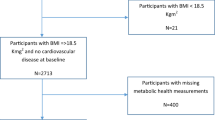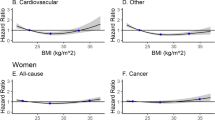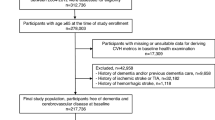Abstract
OBJECTIVE: To examine the prevalence of disease burden and disability associated with overweight and obesity in men aged 60–79 y and to assess whether the current WHO weight guidelines are appropriate in the elderly.
DESIGN: Cross-sectional survey 20 y after enrolment.
SETTING: General practices in 24 British towns.
PARTICIPANTS: In total, 4232 men aged 60–79 y (77% of survivors) with measured weight and height.
MAIN OUTCOME MEASURES: Cardiovascular (CV) risk factors, prevalence of diabetes, cardiovascular disease, cancer, disability and regular medication.
RESULTS: In total, 17% of the men were obese (body mass index (BMI) ≥30 kg/m2) and a further 52% were overweight (BMI 25–29.9 kg/m2). Prevalence of hypertension, low HDL-cholesterol, high triglycerides and insulin resistance and the prevalence of most disease outcomes increased with increasing degrees of overweight/obesity. Men in the normal weight range (18.5–24.9 kg/m2) had the lowest prevalence of ill health. Compared with normal weight men, obese men showed a two-fold risk of major CVD (odds ratio (OR)=1.96, 95% CI 1.44–2.67) and locomotor disability (OR=2.26, 95% CI 1.66, 3.09) and were nearly three times as likely to have diabetes, CV interventions or to be on CV medication. Over 60% of the prevalence of high insulin resistance was attributable to overweight and obesity as was over a third of diabetes and hypertension, a quarter of locomotor disability and a fifth of major CVD.
CONCLUSION: In elderly men, overweight and obesity are associated with a significantly increased burden of disease, in particular CV-related disorders and disability. The current guidelines for overweight and obesity appear to be appropriate in elderly men.
This is a preview of subscription content, access via your institution
Access options
Subscribe to this journal
Receive 12 print issues and online access
$259.00 per year
only $21.58 per issue
Buy this article
- Purchase on Springer Link
- Instant access to full article PDF
Prices may be subject to local taxes which are calculated during checkout

Similar content being viewed by others
References
British Nutrition Foundation's Task Force. Obesity. Blackwell: Oxford, UK; 1999.
National Task Force on the Prevention and Treatment of Obesity. Overweight, obesity and health risk. Arch Int Med 2000; 160: 898–904.
Rossner S . Obesity in the elderly—a future matter of concern? Obes Rev 2001; 2: 183–188.
National Institutes of Health. Clinical guidelines on the identification, evaluation and treatment of overweight and obesity in adults—the evidence report. Obes Res 1998; 6: 51S–209S.
World Health Organisation. Report of a WHO Consultation on Obesity. Obesity: preventing and managing the global epidemic. World Health Organisation: Geneva; 1998.
Heiat A, Vaccarino V, Krumholz M . An evidence-based assessment of federal guidelines for overweight and obesity as they apply to elderly persons. Arch Intern Med 2001; 161: 1194–1203.
Visscher TLS, Seidell JC . The public health impact of obesity. Annu Rev Public Health 2001; 22: 355–375.
Lean MEJ, Han TS, Seidell JC . Impairment of health and quality of life using new US Federal Guidelines for the Identification of Obesity. Arch Intern Med 1999; 159: 837–843.
Must A, Spadano J, Coakley EH, Field AE, Colditz G, Dietz WH . The disease burden associated with overweight and obesity. JAMA 1999; 282: 1523–1529.
Shaper AG, Pocock SJ, Walker M, Cohen NM, Wale CJ, Thomson AG . British Regional Heart Study: cardiovascular risk factors in middle-aged men in 24 towns. BMJ 1981; 283: 179–186.
Walker M, Shaper AG, Lennon L, Whincup PH . Twenty year follow-up of a cohort based in general practices in 24 British towns. J Public Health Med 2000; 22: 479–485.
Wannamethee SG, Lowe GDO, Whincup PH, Rumley A, Walker M, Lennon L . Physical activity and hemostatic and inflammatory variables in elderly men. Circulation 2002; 105: 1785–1790.
Emberson J, Whincup PH, Walker M, Thomas M, Alberti KGMM . Biochemical measures in a population based study: the effect of fasting duration and time of day. Ann Clin Biochem 2002; 39: 493–501.
Whincup PH, Bruce NG, Cook DG, Shaper AG . The Dinamap 1846SX automated blood pressure recorder: comparison with the Hawksley random zero sphygmomanometer under field conditions. J Epidemiol Comm Health 1992; 46: 164–169.
Bruce NG, Cook DG, Shaper AG . Differences between observers in blood pressure measurement with an automatic oscillometric recorder. J Hypertens Suppl 1990; 4: S11–S13.
1999 World Health Organization – International Society of Hypertension Guidelines for the Management of Hypertension. Guidelines Subcommittee. J Hypertens 1999; 17: 151–183.15.
Third report of the National Cholesterol Education Program (NCEP) Expert Panel on detection, evaluation treatment of high blood cholesterol in adults (Adult Treatment Panel III). Final Report. NIH Publication No. 02-5215 2002.
Matthews DR, Hosker JP, Rudenski AS, Naylor BA, Treacher DF, Turner RC . Homeostasis model assessment: insulin resistance and beta-cell function from fasting plasma glucose and insulin concentrations in man. Diabetologia 1985; 28: 412–419.
Wannamethee G, Shaper AG . Weight change in middle-aged British men: implications for health. Eur J Clin Nutr 1990; 44: 133–142.
British National Formulary 1994. Publisher: Joint publication of the British Medical Association and Royal Pharmaceutical Society of Great Britain.
English D, Holman D, Milne E, Winter M, Hulse C, Codde G . The quantification of drug-caused mortality and morbidity in Australia 1992. Commonwealth Department of Human Services and Health 1995: Canberra.
Calle EE, Thun MJ, Petrelli JM, Rodriguez C, Heath CW . Body-mass index and mortality in a prospective cohort of US adults. N Engl J Med 1999; 341: 1097–1105.
Joint Health Surveys Unit on behalf of the Department of Health. 1999 Health Survey for England: Cardiovascular Disease 1998. The Stationary Office: London.
Strawbridge WJ, Walhagen MI, Shema SJ . New NHLBI Clinical guidelines for obesity and overweight: will they promote health. Am J Public Health 2000; 90: 340–343.
Harris TB, Savage PJ, Tell GS, Haan M, Kumanyika S, Lynch JC . Carrying the burden of cardiovascular risk in old age: associations of weight and weight change with prevalent cardiovascular disease, risk factors, and health status in the Cardiovascular Health Study. Am J Clin Nutr 1997; 66: 837–844.
Masaki KH, Curb JD, Chiu D, Petrovich H, Rodriguez BL . Association of body mass index with blood pressure in elderly Japanese men: The Honolulu Heart Program. Hypertension 1997; 29: 673–677.
Visser M, Langlois J, Guralnik JM, Cauley JA, Kronmal RA, Robbins J, Williamson JD, Harris TB . High body fatness, but not low fat-free mass, predicts disability in older men and women: the Cardiovascular Health Study. Am J Clin Nutr 1998; 68: 584–590.
Thomas MC, Walker M, Lennon LT, Thomson AG, Lampe FC, Shaper AG, Whincup PH . Non-attendance at re-examination 20 years after screening in the British Regional Heart Study. J Public Health Med 2002; 24: 285–291.
Harris TB, Launer LJ, Madans J, Feldman JJ . Cohort study of effect of being overweight and change in weight on risk of coronary heart disease in old age. BMJ 1997; 314: 1791–1794.
Baumgartner RN, Heymsfield SB, Roche AF . Human body composition and the epidemiology of chronic disease. Obes Res 1995; 3: 73–95.
Wu CH, Yao WJ, Lu FH, Yang YC, Wu JS, Chang CJ . Sex differences of body fat distribution and cardiovascular dysmetabolic factors in old age. Age Aging 2001; 30: 331–336.
Turcato E, Bosello O, Di Francesco V, Harris TB, Zoico E, Bissoli L, Fracassi E, Zamboni M . Waist circumference and abdominal sagittal diameter as surrogates of body fat distribution in the elderly: their relation with cardiovascular risk factors. Int J Obes Relat Metab Disord 2000; 24: 1005–1010.
Kalmijn S, Curb JD, Rodriguez BL, Yano K, Abbott RD . The association of body weight and anthropometry with mortality in elderly men: the Honolulu Heart Program. Int J Obes Relat Metab Disord. 1999; 23: 395–402.
Baik I, Ascherio A, Rimm EB, Giovannucci E, Spiegelman D, Stampfer MJ, Willett WC . Adiposity and mortality in men. Am J Epidemiol 2000; 152: 264–271.
Visscher TLS, Seidell JC, Molarius A, van der Kuip D, Hofman A, Witteman JCM . A comparison of body mass index, waist-hip ratio and waist circumference as predictors of all-cause mortality among the elderly: the Rotterdam Study. Int J Obesity Relat Metab Disord 2001; 25: 1730–1735.
Janssen I, Katzmarzyk PT, Ross R . Body mass index, waist circumference and health risk. Evidence in support of current National Institutes of Health Guidelines. Arch Intern Med 2002; 162: 2074–2079.
Han TS, van Leer EM, Seidell JC, Lean MEJ . Waist circumference as a screening tool for cardiovascular risk factors: evaluation of receiver operating characteristics (ROC). Obes Res 1996; 4: 533–547.
Acknowledgements
The British Regional Heart Study is a British Heart Foundation Research Group and receives support from the Department of Health (England). The views expressed in this publication are those of the authors and not necessarily those of the Department of Health (England).
Author information
Authors and Affiliations
Corresponding author
Rights and permissions
About this article
Cite this article
Goya Wannamethee, S., Gerald Shaper, A., Whincup, P. et al. Overweight and obesity and the burden of disease and disability in elderly men. Int J Obes 28, 1374–1382 (2004). https://doi.org/10.1038/sj.ijo.0802775
Received:
Revised:
Accepted:
Published:
Issue Date:
DOI: https://doi.org/10.1038/sj.ijo.0802775
Keywords
This article is cited by
-
Predictive equations for fat mass in older Hispanic adults with excess adiposity using the 4‐compartment model as a reference method
European Journal of Clinical Nutrition (2023)
-
Comparison of nutritional status in the elderly according to living situations
The journal of nutrition, health & aging (2017)
-
The combined effect of age and body mass index on outcomes in foregut surgery: a regression model analysis of the National Surgical Quality Improvement Program data
Surgical Endoscopy (2016)
-
Association of BMI and Cardiovascular Risk Stratification in the Elderly African‐American Females
Obesity (2011)
-
The Association of BMI With Functional Status and Self‐rated Health in US Adults
Obesity (2008)



